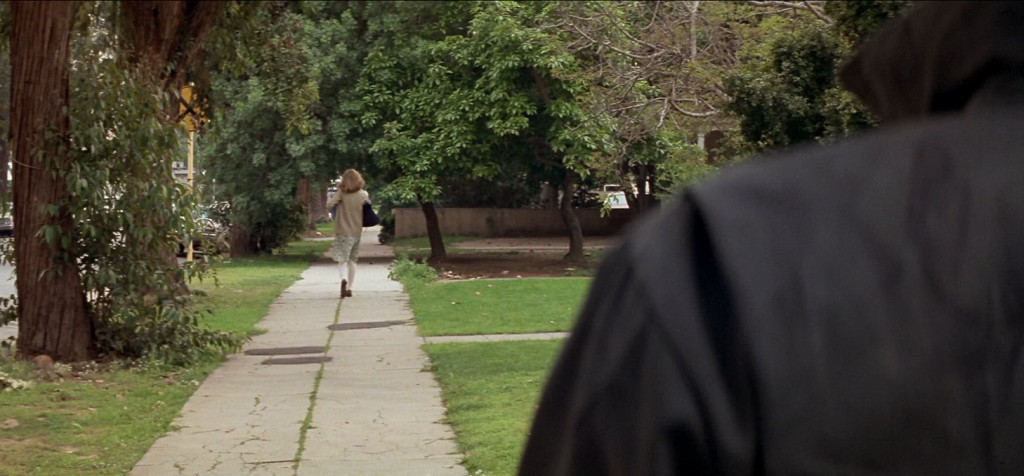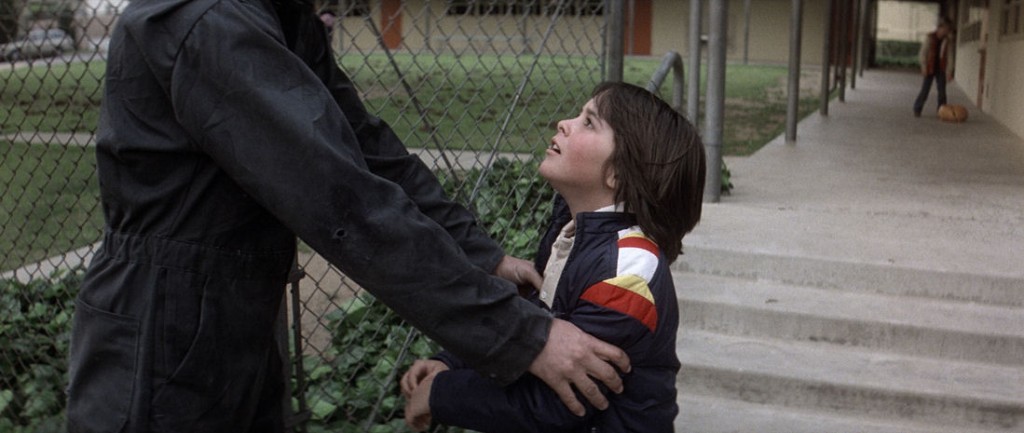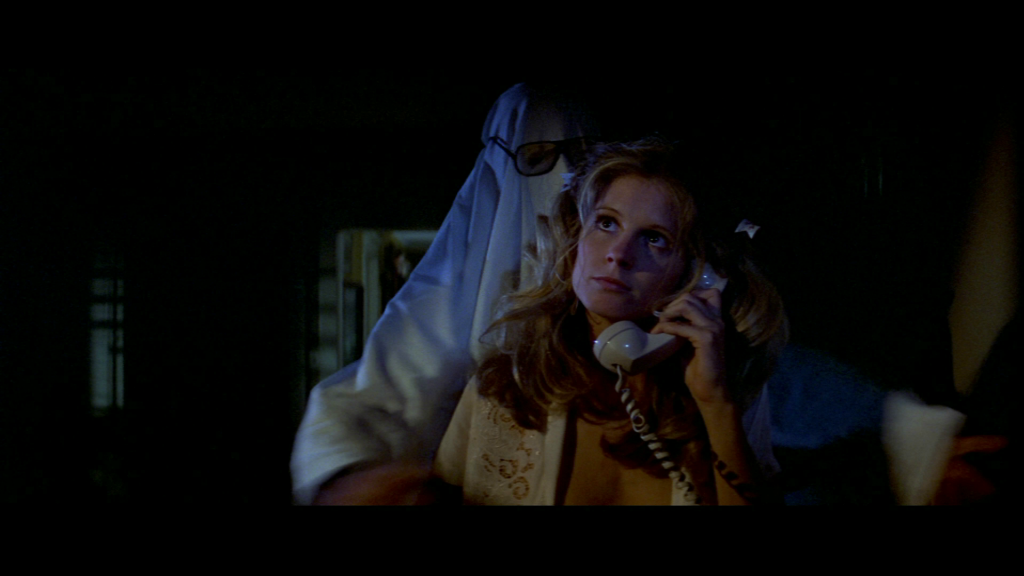
To understand something is to take away its power. A look behind the curtain renders the tricks in front of it less formidable. The mechanical dinosaur isn’t as scary after the director opens it up to show us the gears and pistons that make it move. The things that we understand are less imposing, even if they are beyond our control, because they can be classified, categorized, and broken down into digestible little chunks until they no longer represent the unlimited, terrible possibilities of the unknown.
In Halloween, director John Carpenter never gives the audience a chance to fully understand the monster he crafts in celluloid. He never lets us truly know Michael Myers — what makes him tick, what produced the cold-blooded killer who emerges from the void at the film’s beginning. Indeed, through the character of Dr. Loomis, Carpenter suggests that Michael may very well be something unexplainable, something that cannot be parsed or reduced to understanding. He simply is.
And that’s a sizeable part of what gives Michael Myers so much power on the screen, so much capacity to terrorize and frighten us. Michael stands a step apart from any discernible human thought or feeling. He is simply a force, lurking in the shadows, silent, cold, and methodical as he completes his grisly labors.
Carpenter’s direction magnifies the terror of Michael. His deft use of steadicam places the viewer behind the killer’s eyes, building the suspense as we hear his labored breaths or forcing us to share his unsettling gaze as he stalks a small child. And even in the film’s early moments when the camera is torn away from Michael’s perspective, Carpenter keeps him just outside of the frame, obscured, skulking in the spaces that the screen doesn’t quite reach.
Michael is a threat that is heightened by his absence, by the things about him we cannot see and cannot figure out. In the first half of the film, Carpenter often chooses not to show the horrific acts Michael commits. Instead, he depicts the aftermath of Michael’s trail of terror: a shaken doctor offering warnings and laments, a roadside mechanic splayed out in hay and blood, a headstone torn asunder from the graveyard, a corner store missing both its knives and a mask for the killer to hide behind. Carpenter creates his monster bit by bit, slowly putting the pieces of the puzzle together until Michael emerges, fully formed, nigh-unstoppable and utterly terrifying.
That mask is emblematic of Michael’s otherness. It pulls his visage directly into the uncanny valley, with formless, blank features that look almost otherworldly, but are just human enough to be unsettling. It’s a primal fear that Michael himself embodies in Halloween — something that looks human, that seems human, that walks, talks, and breathes, but which is empty inside, or filled with some detached darkness, to the point that he cannot comprehend the sacredness of the line between life and death.
When he stabs and murders one of his teenage victims, Michael stops for a moment to look at his handiwork. A young man hangs there lifelessly, tacked to the pantry door by his knife. Michael turns his head slightly as he gazes at the impaled corpse, a gesture that suggests he’s examining, but does not understand what he’s done. In these moments, it becomes clear that Michael is not a person, but rather an impulse given free reign. An all-too-human occurrence like death simply washes over him, a minor curiosity that he can barely process, let alone appreciate.
That same unfeeling impulse to kill is what makes the film’s opening sequence, presented from Michael’s first person perspective, so striking and so disturbing. The twist of this introduction is ingenious. This prowling demon, who stalks and kills a lustful young woman, is not some hulking brute, but himself merely a child, who seems uncomprehending of what he’s done. He stands there looking paralyzed but placid, neither ashamed nor proud, as he holds up the tool of his bloody deeds in front of his parents.
And even when he is grown, Halloween’s antagonist is not a snarling villain, or a raging beast, or a calculating mastermind. He is fate, a force of nature personified. Michael is remorseless, and seemingly without emotion. The only small glimpse we see of Michael as a real human being comes toward the end of the film when Laurie tears off the mask that’s been hiding him from the beginning.
Michael immediately halts his attempt to kill Laurie, and we see an expression of mild panic as he pulls the mask back down over his face. For just a moment, Michael is exposed, revealed, however fleetingly, as something human, and that’s an indulgence he cannot abide. Carpenter depicts Michael hiding behind a number of masks over the course of the film, always putting another layer between him and the people whose lives he stamps out.
But Michael is not entirely unexplained. In a manner that could assure concerned city elders that these blood-soaked films were, in fact, morality plays suitable for adolescent consumption, Michael is moved to kill by sin, particularly of the flesh. While he strangles and slashes the teenagers who smoke or drink during the film, from his first kill to his last, what seems to drive him the most is the prospect of young men and women giving into their sexual urges.
And yet we never learn why this bothers him. Dr. Loomis tells his colleague that he’d spent many years trying to reach Michael, trying to understand and rehabilitate him, until he realized that there was nothing there, only a void staring back at him. What’s more, while most of Michael’s victims are guilty of one vice or another, the only real “transgression” from Laurie or Tommy that Michael sees is their approaching his former home.
But the implication is that he looks at Laurie and her young ward, and sees in them the sister who neglected him, the one whom he murdered, and an echo of himself. Michael is just that, an echo of the past, long dormant and contained, now unleashed and set to reenact the events that led to him being locked away. He is a wind-up toy, simply set on this path by an unknown catalyst, following it without thought or care.
But that’s what makes him so frightening. When we see his face emerge from the shadows, we know it’s not a face that can be bargained with, reasoned to, or begged for mercy. It is simply a vision of a ghastly apparition made flesh, of moral disapprobation made lethally manifest. He is a force that never speaks, never thinks, but only acts.
That’s part of why it’s so disquieting when young Tommy finds himself in the role of Cassandra. A recurring theme of Halloween sees multiple characters trying and failing to convince others that Michael is really there and a genuine threat. But Tommy is, for much of the film, the only character who actually witnesses Michael stalking his victims, and appreciates, at an instinctual level, how fearsome he really is.
Tommy sees Michael as “The Bogeyman”, and he tries in vain to convince his babysitter that the monster he’s describing is real. But Laurie dismisses his pleas as just a story, as Tommy’s imagination running away with him. That’s what Michael Myers feels like — a ghost story, an urban legend, something not quite there, not quite real, not to be countenanced until his hands are already wrapped around your neck and it’s too late.
Michael exists on that border, not apparently supernatural like his colleagues from A Nightmare on Elm Street or Friday the 13th, but also not an average, recognizably human murderer either. He is just real enough to feel bound by the rules of our world, but just unreal enough to seem as though he can transgress them, to slip through the shadows like a ghost until it’s time for his blade to be buried in the next victim. That elusiveness, the quality that makes him so doubted within the film, is also makes him powerful and frightening.
Michael's mask began as a cheap Captain Kirk mask. Maybe Laurie's just not a Trekkie.
To the point, one of the film’s most chilling scenes does not involve Michael Myers directly. Instead, it depicts a terrified Laurie banging on the neighbors’ door and begging them for help. The neighbor hears her clamoring, peers through the window, and then just as quickly shuts off the porch lights, leaving Laurie to fend for herself. It’s disturbing in the same way that the (likely apocryphal) story of Kitty Genovese’s murder is.
Throughout the film, Michael, and the people who plead for others to acknowledge his existence, are ignored. He is a creature who could be neutralized, or stopped, or defended against, but no one does, because no one thinks he’s actually there. He is, in the original sense of the term, unbelievable. But that makes it truly menacing when he does appear in those moments when he flits in and out of dark corners, unseen and unbidden, to where by the time he makes his presence known, it’s already too late.
Michael Myers is both the familiar and the other. He is human and specter, man and monster. And the most chilling facet of his being is how he seems so simple, so plain and ordinary behind his dead eyes, so easy to grasp, and yet so utterly alien and cold that he seems incomprehensible, unfit for this world, a creature apart from the peaceful suburb he comes to inhabit. Michael is frightening because he lives in the space between the understood, usual, and unnoticed, and the terrifying forces that we can neither control nor comprehend.





2 Responses to Halloween’s Michael Myers and the Terror of What We Can’t Understand